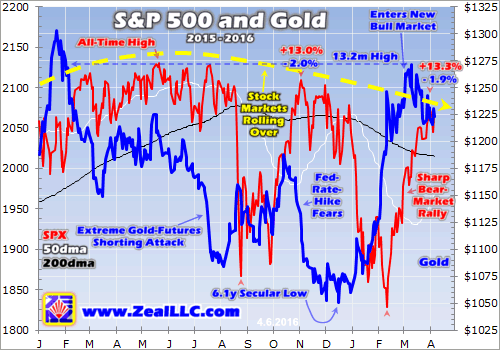Gold has spent much of the past couple months consolidating, vexing traders and bleeding away most of early 2016’s enthusiasm that catapulted the yellow metal higher. But this sideways grind has actually been a very impressive show of strength. Gold managed to hold its massive gains despite an incredible stock-market rally, which can really sap gold investment demand. This portends another major gold upleg.
Gold’s performance this year has been nothing short of remarkable. This unique portfolio-diversifying asset that tends to move counter to stock markets was universally loathed as recently as December. It actually fell to a 6.1-year secular low the day after the Fed’s first rate hike in 9.5 years. The vast majority of investors scoffed at gold, believing it was doomed to spiral lower indefinitely with the Fed tightening.
But such popular antipathy was a dream come true for hardened contrarians who really strive to buy low. With gold hated, the sellers had already sold and its price was way too low relative to its worldwide supply-and-demand picture. On New Year’s Eve when gold closed slightly above that secular low at $1060, I published an essay “Fueling Gold’s 2016 Upleg” arguing “a mighty new gold upleg in 2016” neared.
And indeed that soon came to pass. Fed-rate-hike cycles are actually very bullish for gold historically, contrary to the bearish hype surrounding that first rate hike. The Fed has executed 11 cycles of 3 or more consecutive rate hikes since 1971, and gold’s average gain throughout all of them was 26.9%. In the 6 where it rallied, the more gradual ones launching with gold near major lows, it soared 61.0% on average!
During the last Fed-rate-hike cycle between June 2004 and June 2006, gold powered 49.6% higher. This was despite the Fed hiking 17 consecutive times totaling 425 basis points, more than quintupling its federal-funds rate to 5.25%! So late last year’s popular notion among futures speculators that gold was going to get slaughtered in a rate-hike cycle was utterly ridiculous in light of all historical precedent.
With the dominant bearish-gold theory staked, there was no reason not to be heavily long. Gold started rallying right out of the gates in January as the Fed-levitated US stock markets began selling off. The deeper that selloff grew, the more investors returned to left-for-dead gold. Falling stock markets made them finally remember the millennia-old wisdom of prudent portfolio diversification using the yellow metal.
All this culminated with gold soaring 17.5% in the first 6 weeks or so of 2016 while the flagship S&P 500 stock index plunged 10.5%. The false belief carefully cultivated by central bankers in recent years that they can engineer stock markets to rise indefinitely without material selloffs was starting to implode. So even American stock investors defied their endless Wall Street anti-gold training to flock back to gold.
This was evident in the holdings of the world-leading GLD gold ETF. They surged by 11.5% during that initial 6-week stock-market selloff. Stock investors hadn’t bought gold so aggressively since early 2009, in the early months of a massive gold bull market. Naturally gold excitement was really growing, since everyone loves a winner. But then in mid-February, that major stock-market selloff reversed into a rally.
That stock buying quickly accelerated and drove a gigantic rally that was still forging new highs last week. With stock markets surging, the perceived need to diversify portfolios away from being all-stocks largely evaporated. Thus gold started falling out of favor again, as recent years’ dominating buy-stocks and sell-gold psychological paradigms came roaring back. This could very well have crushed gold.
But it didn’t! Gold defied what is almost certainly a bear-market rally in general stocks, by consolidating high and holding its strong early-year gains. This first chart looks at the gold price superimposed over the benchmark S&P 500 (SPX) over the past 15 months or so. Gold’s resilience and even progress in the face of an exceptional stock-market rally that was a major threat to gold’s sharp gains was amazing.

Between mid-February and early April, the SPX rocketed 13.3% higher in just 7 weeks! That made for one of the biggest intra-quarter recoveries the US stock markets have ever witnessed. Working with Dow 30 data since its history extends back much farther than the S&P 500’s, researchers at a company called My401kPro.com did a fascinating study on intra-quarter rebounds. They started way back in 1900.











Leave A Comment